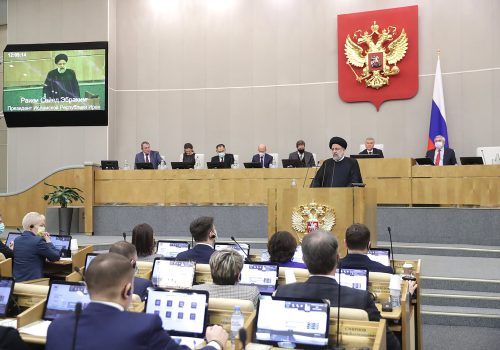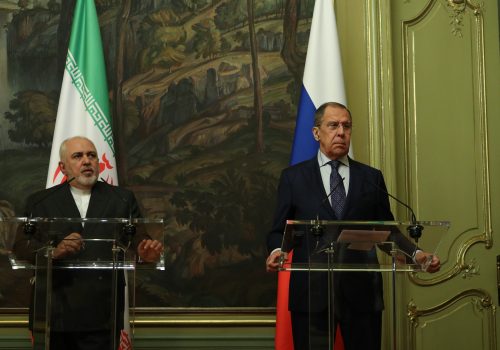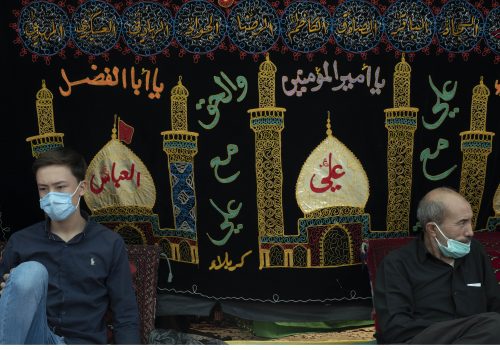Iran is now a transit transportation hub for neighboring countries. Here’s how it happened.
A little more than six months ago, a pair of trucks from the northernmost United Arab Emirates (UAE) princedom of Ras al Khaimah made their way south to the port at Sharjah. The drivers eased them onto a specialized “roll-on, roll-off” ferry that crossed the Persian Gulf to the Iranian port of Bandar Abbas, where they disembarked at the Shahid Bahonar terminal and made a beeline for Iran’s relatively good multi-lane highways.
They headed northwest across the expanse of Iran to the mountainous frontier with Turkey. Then, upon crossing the Bazargan-Gürbulak border, the drivers headed southwest to the Turkish Mediterranean Sea port of Mersin.
Thus, a new trade route was established, one that regional actors are jumping on and could build the kind of trade ties that encourage peaceful relations.
The Iran route makes a lot of sense. In all, the trip from the Arabian Peninsula to the Mediterranean took a mere six days, according to the World Road Transport Organization (IRU), the international truck and transport lobby. That’s a fraction of the twenty-one days or so it would take to get a shipment from the Persian Gulf to the Red Sea through the bottleneck at the Suez Canal and into the Mediterranean Sea.
But that it took until October 2021 for the corridor to be opened suggests how fragmented the Middle East has become, and how much economically healthier it could be. Like in North Africa, neighboring nations act more like islands than partners.
“The biggest historical abnormality is the absence of [Iran] from the global trading system,” said Matt Oresman, a partner at Pillsbury, an international law firm, who specializes in international sanctions and trade law. “This makes imminent sense historically and geographically that Iran would play this role.”
Since the Iran trade route was opened, roughly one thousand trucks have made the trip between Turkey and the UAE, mostly carrying goods from west to east, according to numbers provided by the trade office of the Turkish presidency.
The products, which are worth millions in total, include consumer durables, foodstuff, cosmetics, machinery, spare parts, and personal belongings for expatriates moving back and forth. The trips are facilitated by a single set of $30 transit documents issued by the International Road Transport organization, which are valid in dozens of Eurasian nations.
Pakistan is also taking advantage of a newly launched overland Iranian route to Turkey, which cuts travel times for goods between South Asia and Europe from upwards of forty days by sea down to as little as a week.
Additionally, Central Asian nations worried about bottlenecks at Caspian Sea ports that have caused weeks of delays—as well as a war raging in Ukraine that has impeded Eurasian traffic—are looking to Iran to get goods back and forth.
Commercially, the use of Iran as a land route also makes sense. A global container shortage has upped the cost of sea freight and the threat of piracy or terrorism at sea has jacked up insurance rates. A land option roughly coinciding with the ancient Silk Road connecting Asia to Europe reduces transit times, lowers insurance and refrigeration costs, eases other transport bottlenecks, and could alleviate supply-chain shortages, benefiting businesses and consumers worldwide.
Other land options are less feasible. Currently, Iraq bars transit transportation within its borders and huge areas of Syria remain unstable and in a state of armed conflict. That leaves Iran.
Turkish officials told me that three hundred-odd truck trips were carried out along the route in the last few months of 2021, and the number has exceeded seven hundred during the first five months of this year.
Further economic integration with Iran, while a boon for business, will likely undermine ongoing attempts by the United States to keep it isolated. Parts of the Bandar Abbas port remain specifically under US sanctions. However, there is evidence that, at least in this case, regional nations are choosing to ignore American preferences.
Turkish transport officials told me that there are still many kinks to iron out. For example, Iran’s weekends fall on Thursday afternoons and Fridays, while Turkey’s are on Saturday and Sunday, sometimes causing long waits at the Bazargan border crossing. Limits on fuel at petrol stations in Iran mean that drivers must stop to fill up their tanks every few hours.
Still, two well-connected interlocutors told me that the Iran trade route is proving so attractive that it is among the driving forces behind recent regional diplomacy. Shortly after the transport corridor was established, UAE ruler Mohammed bin Zayed came to Turkey in November 2021 to meet with President Recep Tayyip Erdogan. The two leaders put aside years of differences over Libya and Syria, as well as over their conflicting ideological visions for the Middle East, to discuss trade and investment deals.
Economist Selim Koru said that it was among the factors that encouraged Erdogan to lay aside past grievances and embrace the Saudi leadership, including Crown Prince Mohammed bin Salman, at a meeting in Jeddah in April. Several sources said that it is among the factors pushing recent Baghdad-hosted talks between Saudi Arabia and Iran.
Recognizing the potential for opening land transport, the Iraqi government is considering opening its territory for transit vehicles.
Overwhelmed by the war in Ukraine, the US government has, for now, looked the other way at signs that Iran is being integrated into the region. Perhaps that is for the best.
In the West, political theorists have long abandoned the once-popular theory that increasing trade and prosperity would empower the middle classes in authoritarian nations to lead their nations to liberal democracy. In fact, as they became richer, Brazil, China, India, and Russia became more repressive, less liberal, and even more internationally belligerent. In Iran, Turkey, and the Gulf states, economic prosperity has failed to lead to democratic change.
But, at the very least, trade routes and economic interdependencies can establish a measure of rationality and efficiency, and perhaps create incentives for peace between longtime adversaries, just as integrating the French and German steel industries after World War II made yet another armed conflict between the two nations almost literally impossible. For now, such modest ambitions for the Middle East may be the best policymakers can hope for.
Borzou Daragahi is an international correspondent for The Independent. He has covered the Middle East and North Africa since 2002. He is also a Nonresident Fellow with the Atlantic Council’s Middle East Security Initiative. Follow him on Twitter: @borzou.
Further reading
Mon, Mar 7, 2022
As the world shuns Russia over its invasion of Ukraine, Iran strengthens its ties with Moscow
IranSource By
Iran’s support for Russian actions reflects the improvement in bilateral ties, which have grown considerably at the political and military levels over the past decade.
Tue, Jan 19, 2021
Does Russia really want a US return to the Iran deal?
IranSource By
The Kremlin has also backed European efforts to save the Joint Comprehensive Plan of Action since the US’s unilateral withdrawal from the deal in 2018. Below the surface, however, Russia’s views may be more complicated and ambivalent.
Fri, Aug 20, 2021
Iran spent years preparing for a Taliban victory. It may still get stung.
IranSource By Borzou Daragahi
Iran’s relatively sanguine stance toward the Taliban’s takeover of Afghanistan demonstrates, above all, the strides Tehran has made in improving its relations with the armed insurgent network that was once considered a mortal enemy of the Islamic Republic.
Image: Iraqi workers unload a truck from Iran, loaded with cosmetics, in Baghdad, Iraq August 17, 2018. REUTERS/Khalid Al-Mousily


